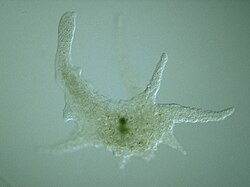
Back أميبيات Arabic اميبيات ARZ Amoebozoa Byelorussian Amoebozoa Bulgarian অ্যামিবোজোয়া Bengali/Bangla Amoebozoa BS Amebozous Catalan Amoebozoa Czech Amoebozoa German Amoebozoa Esperanto
| Amoebozoa Temporal range:
| |
|---|---|

| |
| Chaos carolinensis | |
| Scientific classification | |
| Domain: | Eukaryota |
| Clade: | Amorphea |
| Phylum: | Amoebozoa Lühe, 1913 emend. Cavalier-Smith, 1998[3] |
| Clades[4][5] | |
| Synonyms | |
| |
Amoebozoa is a major taxonomic group containing about 2,400 described species of amoeboid protists,[7] often possessing blunt, fingerlike, lobose pseudopods and tubular mitochondrial cristae.[6][8] In traditional classification schemes, Amoebozoa is usually ranked as a phylum within either the kingdom Protista[9] or the kingdom Protozoa.[10][11] In the classification favored by the International Society of Protistologists, it is retained as an unranked "supergroup" within Eukaryota.[6] Molecular genetic analysis supports Amoebozoa as a monophyletic clade. Modern studies of eukaryotic phylogenetic trees identify it as the sister group to Opisthokonta, another major clade which contains both fungi and animals as well as several other clades comprising some 300 species of unicellular eukaryotes.[7][8] Amoebozoa and Opisthokonta are sometimes grouped together in a high-level taxon, variously named Unikonta,[10] Amorphea[6] or Opimoda.[12]
Amoebozoa includes many of the best-known amoeboid organisms, such as Chaos, Entamoeba, Pelomyxa and the genus Amoeba itself. Species of Amoebozoa may be either shelled (testate) or naked, and cells may possess flagella. Free-living species are common in both salt and freshwater as well as soil, moss and leaf litter. Some live as parasites or symbionts of other organisms, and some are known to cause disease in humans and other organisms.
While the majority of amoebozoan species are unicellular, the group also includes several clades of slime molds, which have a macroscopic, multicellular stage of life during which individual amoeboid cells remain together after multiple cell division to form a macroscopic plasmodium or, in cellular slime molds, aggregate to form one.
Amoebozoa vary greatly in size. Some are only 10–20 μm in diameter, while others are among the largest protozoa. The well-known species Amoeba proteus, which may reach 800 μm in length, is often studied in schools and laboratories as a representative cell or model organism, partly because of its convenient size. Multinucleate amoebae like Chaos and Pelomyxa may be several millimetres in length, and some multicellular amoebozoa, such as the "dog vomit" slime mold Fuligo septica, can cover an area of several square meters.[13]
- ^ Cite error: The named reference
Porter_2003was invoked but never defined (see the help page). - ^ Cite error: The named reference
Parfrey2011was invoked but never defined (see the help page). - ^ Cite error: The named reference
6kingdomwas invoked but never defined (see the help page). - ^ Cite error: The named reference
Adl_2019was invoked but never defined (see the help page). - ^ a b Cite error: The named reference
BetweenPodwas invoked but never defined (see the help page). - ^ a b c d Adl SM, Simpson AG, Lane CE, Lukeš J, Bass D, Bowser SS, et al. (September 2012). "The revised classification of eukaryotes". The Journal of Eukaryotic Microbiology. 59 (5): 429–93. doi:10.1111/j.1550-7408.2012.00644.x. PMC 3483872. PMID 23020233.
- ^ a b Pawlowski J, Audic S, Adl S, Bass D, Belbahri L, Berney C, et al. (November 6, 2012). "CBOL protist working group: barcoding eukaryotic richness beyond the animal, plant, and fungal kingdoms". PLOS Biology. 10 (11): e1001419. doi:10.1371/journal.pbio.1001419. PMC 3491025. PMID 23139639.
- ^ a b Cavalier-Smith T, Fiore-Donno AM, Chao E, Kudryavtsev A, Berney C, Snell EA, Lewis R (February 2015). "Multigene phylogeny resolves deep branching of Amoebozoa". Molecular Phylogenetics and Evolution. 83: 293–304. doi:10.1016/j.ympev.2014.08.011. PMID 25150787.
- ^ Corliss JO (1984). "The Kingdom Protista and its 45 Phyla". BioSystems. 17 (2): 87–126. doi:10.1016/0303-2647(84)90003-0. PMID 6395918.
- ^ a b Cavalier-Smith T (2003). "Protist phylogeny and the high-level classification of Protozoa". European Journal of Protistology. 39 (4): 338–348. doi:10.1078/0932-4739-00002.
- ^ Ruggiero, Michael A.; Gordon, Dennis P.; Orrell, Thomas M.; Bailly, Nicolas; Bourgoin, Thierry; Brusca, Richard C.; Cavalier-Smith, Thomas; Guiry, Michael D.; Kirk, Paul M. (2015-06-11). "Correction: A Higher Level Classification of All Living Organisms". PLOS ONE. 10 (6): e0130114. doi:10.1371/journal.pone.0130114. ISSN 1932-6203. PMC 5159126. PMID 26068874.
- ^ Cite error: The named reference
Derelle_2015was invoked but never defined (see the help page). - ^ Zhulidov DA, Robarts RD, Zhulidov AV, Zhulidova OV, Markelov DA, Rusanov VA, Headley JV (2002). "Zinc accumulation by the slime mold Fuligo septica (L.) Wiggers in the former Soviet Union and North Korea". Journal of Environmental Quality. 31 (3): 1038–42. doi:10.2134/jeq2002.1038. PMID 12026071.
Cite error: There are <ref group=lower-alpha> tags or {{efn}} templates on this page, but the references will not show without a {{reflist|group=lower-alpha}} template or {{notelist}} template (see the help page).
© MMXXIII Rich X Search. We shall prevail. All rights reserved. Rich X Search